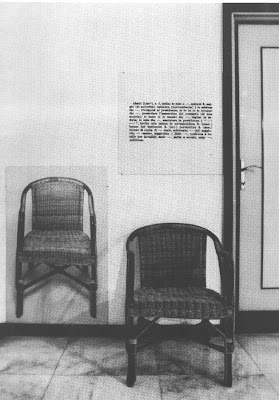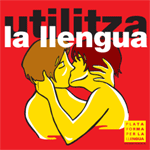






One and three chairs (1965), de Joseph Kosuth
Kosuth, nascut a la Toledo d'Ohio l'any 1945, és un dels artistes més lexicogràfics de la història.
En aquest fragment d'una entrevista a Kosuth de l'any 1970 explica les instruccions per al muntatge de l'obra i les variacions en cada museu:
Aquesta obra pertany a la seva sèrie "Proto-investigations", títol que fa referència al llibre Investigacions filosòfiques, de Ludwig Wittgenstein. Les tres representacions de la cadira (la de fusta, la fotogràfica i la lexicogràfica) remeten a una sola cadira: el concepte de cadira, que no és material, però les engloba. Art conceptual. Allò que importa és el concepte, per això depenent del museu, l'obra canvia d'aspecte, com podem comprovar. La definició del diccionari va ser originàriament en anglès, però depenent del lloc on s'exhibia l'obra, aquesta definició podia trobar-se en d'altres llengües.
En aquest fragment d'una entrevista a Kosuth de l'any 1970 explica les instruccions per al muntatge de l'obra i les variacions en cada museu:
"I used common, functional objects - such as a chair - and to the left of the object would be a full-scale photograph of it and to the right of the object would be a photostat of a definition of the object from the dictionary. Everything you saw when you looked at the object had to be the same that you saw in the photograph, so each time the work was exhibited the new installation necessitated a new photograph. I liked that the work itself was something other than simply what you saw. By changing the location, the object, the photograph and still having it remain the same work was very interesting. It meant you could have an art work which was that idea of an art work, and its formal components weren't important." WBAI, April 7, 1970 (Siegel, Jeanne: Artwords. Discourse on the 60s and 20s. UMI Research Press, Ann Arbour/Michigan 1985; second edition Da Capo Press, New York 1992, p. 225)















Cap comentari:
Publica un comentari a l'entrada
Quelcom a dir?